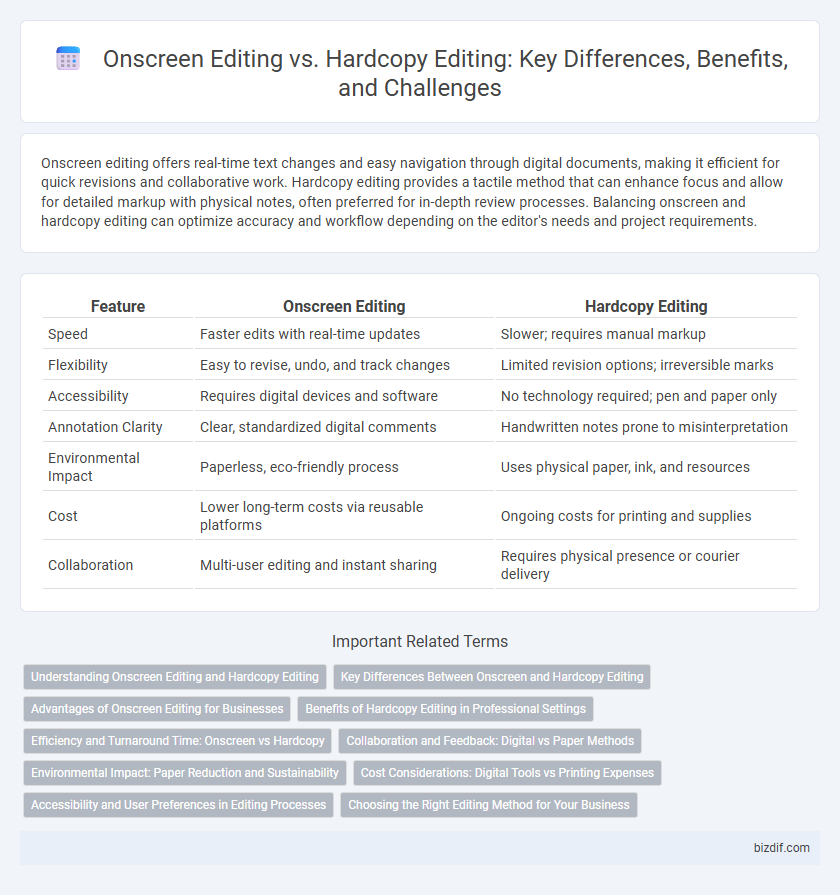Onscreen editing offers real-time text changes and easy navigation through digital documents, making it efficient for quick revisions and collaborative work. Hardcopy editing provides a tactile method that can enhance focus and allow for detailed markup with physical notes, often preferred for in-depth review processes. Balancing onscreen and hardcopy editing can optimize accuracy and workflow depending on the editor's needs and project requirements.
Table of Comparison
| Feature | Onscreen Editing | Hardcopy Editing |
|---|---|---|
| Speed | Faster edits with real-time updates | Slower; requires manual markup |
| Flexibility | Easy to revise, undo, and track changes | Limited revision options; irreversible marks |
| Accessibility | Requires digital devices and software | No technology required; pen and paper only |
| Annotation Clarity | Clear, standardized digital comments | Handwritten notes prone to misinterpretation |
| Environmental Impact | Paperless, eco-friendly process | Uses physical paper, ink, and resources |
| Cost | Lower long-term costs via reusable platforms | Ongoing costs for printing and supplies |
| Collaboration | Multi-user editing and instant sharing | Requires physical presence or courier delivery |
Understanding Onscreen Editing and Hardcopy Editing
Onscreen editing involves making corrections directly within digital documents using software tools, enabling real-time adjustments and streamlined collaboration. Hardcopy editing requires printing the document and marking errors or revisions manually on paper, offering a tactile approach that some editors find useful for catching details. Both methods complement each other, as onscreen editing leverages technology for efficiency while hardcopy editing provides a physical perspective for thorough review.
Key Differences Between Onscreen and Hardcopy Editing
Onscreen editing allows for real-time text modifications with tools like track changes and comments, enhancing collaboration and efficiency. Hardcopy editing involves manual markups on printed documents, providing tactile engagement and often improving focus on detailed errors. The key differences lie in the medium used, speed of revisions, and the level of interaction with the text.
Advantages of Onscreen Editing for Businesses
Onscreen editing offers businesses enhanced efficiency by enabling real-time changes and immediate visual feedback, reducing turnaround times significantly compared to hardcopy editing. This digital approach minimizes paper waste and associated costs, promoting eco-friendly practices and budget savings. Collaborative tools integrated with onscreen editing platforms allow multiple users to annotate, review, and finalize documents simultaneously, streamlining workflows and improving communication across teams.
Benefits of Hardcopy Editing in Professional Settings
Hardcopy editing enhances focus by eliminating digital distractions, allowing editors to catch errors and inconsistencies more effectively in professional settings. Tactile interaction with physical documents facilitates a deeper engagement with the text, promoting meticulous review and improved comprehension. The permanence of annotations on hardcopy materials ensures clear communication among editorial teams and preserves critical feedback throughout the revision process.
Efficiency and Turnaround Time: Onscreen vs Hardcopy
Onscreen editing significantly enhances efficiency by allowing instant changes, streamlined navigation, and integrated tools that reduce the need for physical materials. Turnaround time is accelerated as edits can be made, reviewed, and shared electronically in real-time, eliminating delays caused by printing and manual corrections. In contrast, hardcopy editing involves slower processing due to physical handling, increased risk of misplaced annotations, and additional time for scanning or retyping edits into digital formats.
Collaboration and Feedback: Digital vs Paper Methods
Onscreen editing facilitates real-time collaboration by allowing multiple users to access, comment, and revise documents simultaneously, streamlining feedback integration through digital tools such as tracked changes and shared annotations. Hardcopy editing relies on physical markups, which can slow down the feedback process and requires manual consolidation of comments from different reviewers. Digital methods enhance transparency and efficiency in teamwork, while paper methods offer tactile engagement but often hinder rapid collaboration and iterative editing.
Environmental Impact: Paper Reduction and Sustainability
Onscreen editing significantly reduces paper consumption, promoting sustainability by minimizing deforestation and waste associated with hardcopy editing. Digital tools allow for efficient revisions without generating physical drafts, cutting down on carbon emissions from paper production and transportation. This shift supports environmental conservation efforts and aligns with eco-friendly publishing practices.
Cost Considerations: Digital Tools vs Printing Expenses
Onscreen editing significantly reduces costs by eliminating the need for physical printing, thereby lowering expenses associated with paper, ink, and postage. Digital tools enable real-time revisions and seamless collaboration, minimizing turnaround times and further cutting operational costs. In contrast, hardcopy editing incurs recurring printing costs and increased resource consumption, making digital editing a more budget-friendly option for content refinement.
Accessibility and User Preferences in Editing Processes
Onscreen editing offers enhanced accessibility by allowing users to make real-time changes with digital tools, improving efficiency and ease of use. Hardcopy editing appeals to those who prefer tactile interaction and find physical annotation more intuitive, supporting diverse user preferences. Balancing onscreen and hardcopy methods accommodates varied accessibility needs and optimizes the overall editing process.
Choosing the Right Editing Method for Your Business
Selecting the optimal editing method hinges on your business's workflow, document type, and budget constraints. Onscreen editing leverages digital tools for real-time collaboration, version control, and faster revisions, ideal for businesses prioritizing efficiency and sustainability. Hardcopy editing offers tangible markup advantages and can be preferred for legal or highly detailed documents requiring meticulous manual review.
Onscreen Editing vs Hardcopy Editing Infographic

 bizdif.com
bizdif.com